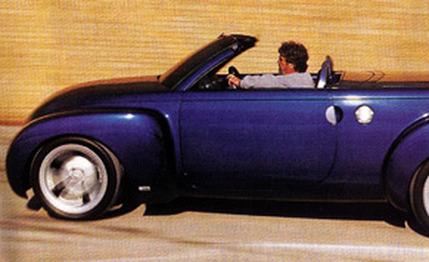 Road Test
Road Test
Forgive Ed Welburn if he's a bit smug, but the Chevrolet SSR concept vehicle, which Chevy hoped might make a modest splash at Detroit's concept-crowded auto show, made a major splash.
If Chevrolet executives were sitting on the fence about putting the SSR into production, the public reaction to the concept pushed them over. Expect it in 2002, as a 2003 model.
And what you see here is--what, exactly? A pickup truck? A hot rod? The reincarnation of the El Camino?
First and foremost, it's a roadster, says Welburn, who is the director of GM's Corporate Brand Character Center, where the SSR -- for "Super Sport Roadster" -- was designed. "It's made to drive. I can see driving it in Southern California, or in Miami, or on winding roads in New England, or in the Woodward Dream Cruise [in Detroit]. The SSR is all about enjoying driving. It's that simple."
Early on, someone suggested the SSR should be able to haul Jet Skis and snowmobiles. "I disagreed," Welburn says. "We have plenty of other vehicles that are for hauling. This one needs to be about driving."
Design inspiration would focus on a Chevy pickup, but of what vintage? Pickups from the '30s, '50s, and '70s were scrutinized before settling on a 1953 truck, seen in the SSR in the big horizontally barred grille, in the rounded fenders, in the split windshield, in the twin-cockpit interior. (Get used to the massive brushed aluminum accent across the grille -- that's the new Chevy truck trademark look.)
That was July 1999. Very early sketches were transferred to the computer, and the entire design took shape -- all on computers. Welburn says no vehicle at GM has ever gone from idea to running model with all the design done entirely on a computer. He says it would make production possible much sooner, as not only the exterior and interior styling have been done, but the mechanical details as well. When the production team starts on the SSR, a majority of the engineering will already have been completed. Basic crashworthiness tests have also been done on the computer, as well as some aerodynamic work.
The SSR also validates the idea that a warm, organic shape -- not just a severe, angular form like the Cadillac Evoq--can be designed using a computer. "Historically," Welburn says, "a lot of us have been concerned about designs generated in a computer -- that they couldn't have the emotion of a design that evolved through artists working in clay, shoving it around -- but I think this is proof you can. We still have the artists, but instead of working in clay, they're working on computers. You saw the reaction at the show to the SSR -- people really responded to it."
Next came the details. The SSR needed a reasonably compact rear-wheel-drive platform, and the best available was a stretched Blazer chassis. The five-door Blazer has a 107.0-inch wheelbase; the SSR's wheelbase is 116.5 inches. Overall length is 186.1 inches, about two inches longer than a Blazer.
Beneath the handsome engine cover is a 6.0-liter V-8 from the three-quarter-ton Silverado pickup. It's a stock 300-hp engine, although with the dual Flowmaster mufflers it likely makes a few additional ponies. The 6.0-liter engine is the same size on the outside as its 4.8- and 5.3-liter cousins, and any of those could find their way into the production car.
The transmission is the full-size Silverado's four-speed automatic, controlled by two buttons on the three-spoke steering wheel. In park, click the button on the right three times, and you go to reverse, to neutral, to drive. The button on the left reverses the process. Early plans suggested a floor shifter, or even a manual transmission, but the steering-wheel setup was chosen to clear floor space. "You can squeeze a third person in between the driver and passenger, at least for short trips," Welburn says. "You can't do that in a typical roadster."
The interior is clean and functional. A flip-up dash panel reveals a stereo with a CD player. The instruments are handsome and traditional. Pop the glove-compartment door, and you see that this is indeed a show vehicle -- there's a myriad of wiring and electrical connections that lead to the four onboard computers which not only carry out typical functions but also handle the show-biz stuff, such as floor mats stitched with fiber optics that spell out the SSR's name in lights.